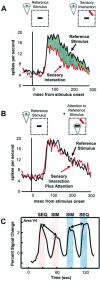Neuroimaging studies of attention: from modulation of sensory processing to top-down control
- PMID: 12764083
- PMCID: PMC6741071
- DOI: 10.1523/JNEUROSCI.23-10-03990.2003
Neuroimaging studies of attention: from modulation of sensory processing to top-down control
Figures


Similar articles
-
[Neurophysiological mechanisms of voluntary attention: a review].Zh Vyssh Nerv Deiat Im I P Pavlova. 2003 Mar-Apr;53(2):133-50. Zh Vyssh Nerv Deiat Im I P Pavlova. 2003. PMID: 12754839 Review. Russian.
-
Neural mechanisms of global and local processing. A combined PET and ERP study.J Cogn Neurosci. 1998 Jul;10(4):485-98. doi: 10.1162/089892998562898. J Cogn Neurosci. 1998. PMID: 9712678
-
Sensory gain control (amplification) as a mechanism of selective attention: electrophysiological and neuroimaging evidence.Philos Trans R Soc Lond B Biol Sci. 1998 Aug 29;353(1373):1257-70. doi: 10.1098/rstb.1998.0281. Philos Trans R Soc Lond B Biol Sci. 1998. PMID: 9770220 Free PMC article.
-
How brains beware: neural mechanisms of emotional attention.Trends Cogn Sci. 2005 Dec;9(12):585-94. doi: 10.1016/j.tics.2005.10.011. Epub 2005 Nov 10. Trends Cogn Sci. 2005. PMID: 16289871
-
Dissociating top-down attentional control from selective perception and action.Neuropsychologia. 2001;39(12):1277-91. doi: 10.1016/s0028-3932(01)00117-8. Neuropsychologia. 2001. PMID: 11566311 Review.
Cited by
-
Unveiling Dynamic System Strategies for Multisensory Processing: From Neuronal Fixed-Criterion Integration to Population Bayesian Inference.Research (Wash D C). 2022 Aug 19;2022:9787040. doi: 10.34133/2022/9787040. eCollection 2022. Research (Wash D C). 2022. PMID: 36072271 Free PMC article.
-
The effects of stimulus degradation after 48 hours of total sleep deprivation.Sleep. 2012 Jan 1;35(1):113-21. doi: 10.5665/sleep.1598. Sleep. 2012. PMID: 22215925 Free PMC article.
-
Prefrontal theta modulates sensorimotor gamma networks during the reorienting of attention.Hum Brain Mapp. 2020 Feb 1;41(2):520-529. doi: 10.1002/hbm.24819. Epub 2019 Oct 17. Hum Brain Mapp. 2020. PMID: 31621977 Free PMC article.
-
The neural correlates of feature-based selective attention when viewing spatially and temporally overlapping images.Neuropsychologia. 2007 Apr 8;45(7):1393-9. doi: 10.1016/j.neuropsychologia.2006.10.019. Epub 2006 Dec 11. Neuropsychologia. 2007. PMID: 17161441 Free PMC article.
-
Spatial attention: more than intrinsic alerting?Exp Brain Res. 2006 May;171(1):16-25. doi: 10.1007/s00221-005-0253-1. Epub 2005 Nov 24. Exp Brain Res. 2006. PMID: 16307253
References
-
- Aggleton J ( 2000) The amygdala: a functional analysis. Oxford: Oxford UP.
-
- Beauchamp MS, Cox RW, DeYoe EA ( 1997) Graded effects of spatial and featural attention on human area MT and associated motion processing areas. J Neurophysiol 78: 516–620. - PubMed
-
- Beauchamp MS, Petit L, Ellmore TM, Ingeholm J, Haxby JV ( 2001) A parametric fMRI study of overt and covert shifts of visuospatial attention. NeuroImage 14: 310–321. - PubMed
-
- Bichot NP, Schall JD ( 1999) Effects of similarity and history on neural mechanisms of visual selection. Nat Neurosci 2: 549–554. - PubMed
-
- Brefczynski JA, DeYoe EA ( 1999) A physiological correlate of the “spotlight” of visual attention. Nat Neurosci 2: 370–374. - PubMed
Publication types
MeSH terms
LinkOut - more resources
Full Text Sources
Medical
